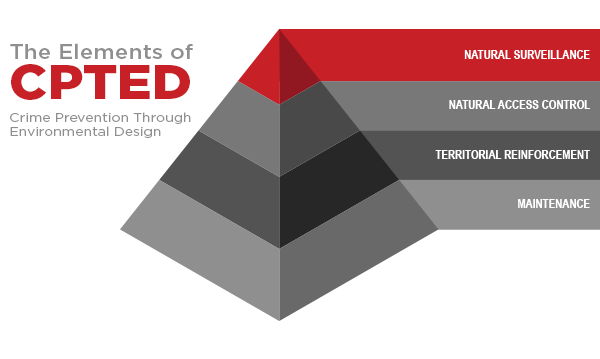The most effective physical security is more than the latest integrated electronic technology custom-designed to meet the challenges of the customer and the protected premises. It starts at the farthest reaches of the facility’s perimeter and that’s where the concept of Crime Prevention through Environmental Design (CPTED) comes into play.
The Concept of CPTED
CPTED, also known as The CPTED Methodology, originated in the 1960s with a focus on safe communities and neighborhoods. The methodology is based on the idea that the more barriers you provide to the outside areas of the protected premises the harder it will be for the building to be breached or compromised. This concept fits well into the physical security industry’s mandate to layer various levels of security to minimize the possibility of intrusion or even attack.
The International CPTED Association defines its principles as “a multi-disciplinary approach for reducing crime through urban and environmental design and the management and use of built environments. CPTED strategies aim to reduce victimization, deter offender decisions that precede criminal acts and build a sense of community among the inhabitants so they can gain territorial control of areas and reduce opportunities for crime and fear of crime.” The four overlapping CPTED strategies include natural surveillance, natural access control, territorial reinforcement, and maintenance. The idea is far-reaching and multi-faceted, but overall prevents or delays crime by manipulating the built environment in such a way as to make potential malicious breaches harder—so criminals eventually give up or are apprehended before an incident or harm occurs
Simple Steps Add Up Big
CPTED includes hardening the target (factory, building, campus) with physical barriers such as masonry walls, stronger more formidable fencing, privacy fencing, metal detectors, controlled entry points (choke points) lighting or preventative barriers, such as shrubbery, proper fence line static or motion lighting. Part of the planning for CPTED design involves making sure entrance and egress is not impeded and building occupants have easy access to their place of work, without burdening occupants with overly restrictive designs.
Any total physical and logical security and access control solution starts with targeting the outside of the building and facility, looking at possible vulnerabilities. After a thorough risk assessment and analysis, we might advise simple deterrents, such as bushes, bollards, gates, and strategically placed lighting, to more extensive CPTED processes, such as gates and parking controls integrated with electronic access control or video surveillance. Many of these strategies can be effectively combined with security technology—such as using video surveillance with analytics to alert operators to intruders in off-limit areas.
Augmenting physical security with the applied controls of CPTED is critical to comprehensive safety and security. It’s a combined, total solution and not one concept or technology that provides best practices in risk, security and threat management. If you have questions about securing your facility, contact the experts at Sierra Group today at 1-888-880-4949.








